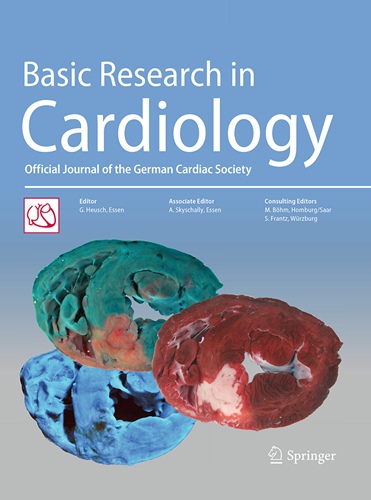在小鼠压力过载模型中,aav介导的CPT1B过表达可防止心脏肥厚和心力衰竭。
IF 8
1区 医学
Q1 CARDIAC & CARDIOVASCULAR SYSTEMS
引用次数: 0
摘要
从心脏肥厚到心力衰竭的转变以代谢变化为特征,如脂肪酸代谢的下调,有利于葡萄糖利用的增加。肉碱棕榈酰基转移酶1B (CPT1B)催化肉碱穿梭的限速步骤,是脂肪酸氧化的必需酶。CPT1B活性下调与患者和各种实验模型的心力衰竭有关,表明其在代谢重塑中起重要作用。因此,我们旨在研究CPT1B过表达是否在心力衰竭中发挥治疗作用。利用腺相关病毒(AAV)载体将CPT1B基因转移到新生大鼠心肌细胞中,可显著减轻苯肾上腺素诱导的心肌肥大,减少线粒体活性氧的产生。在横断主动脉收缩小鼠中,aav介导的CPT1B过表达在体内减轻了心肌细胞肥大、心脏纤维化和收缩功能障碍。因此,上调CPT1B的表达可能是治疗或预防心力衰竭的一种有希望的方法。本文章由计算机程序翻译,如有差异,请以英文原文为准。
AAV-mediated overexpression of CPT1B protects from cardiac hypertrophy and heart failure in a murine pressure overload model.
The transition from cardiac hypertrophy to heart failure is characterized by metabolic changes like downregulation of fatty acid metabolism in favor of increased glucose utilization. Carnitine palmitoyltransferase 1B (CPT1B) catalyzes the rate-limiting step of the carnitine shuttle and is an essential enzyme for fatty acid oxidation. Down-regulation of CPT1B activity has been associated with heart failure in patients and various experimental models, indicating an important role in metabolic remodeling. Therefore, we aimed to investigate whether CPT1B overexpression could play a therapeutic role in heart failure. Gene transfer of CPT1B using adeno-associated virus (AAV) vectors into neonatal rat cardiomyocytes significantly attenuated phenylephrine-induced hypertrophy and resulted in decreased generation of mitochondrial reactive oxygen species. In mice subjected to transverse aortic constriction, AAV-mediated cardiac overexpression of CPT1B attenuated cardiomyocyte hypertrophy, cardiac fibrosis, and systolic dysfunction in vivo. Upregulation of CPT1B expression might therefore represent a promising approach to treat or prevent heart failure.
求助全文
通过发布文献求助,成功后即可免费获取论文全文。
去求助
来源期刊

Basic Research in Cardiology
医学-心血管系统
CiteScore
16.30
自引率
5.30%
发文量
54
审稿时长
6-12 weeks
期刊介绍:
Basic Research in Cardiology is an international journal for cardiovascular research. It provides a forum for original and review articles related to experimental cardiology that meet its stringent scientific standards.
Basic Research in Cardiology regularly receives articles from the fields of
- Molecular and Cellular Biology
- Biochemistry
- Biophysics
- Pharmacology
- Physiology and Pathology
- Clinical Cardiology
 求助内容:
求助内容: 应助结果提醒方式:
应助结果提醒方式:


